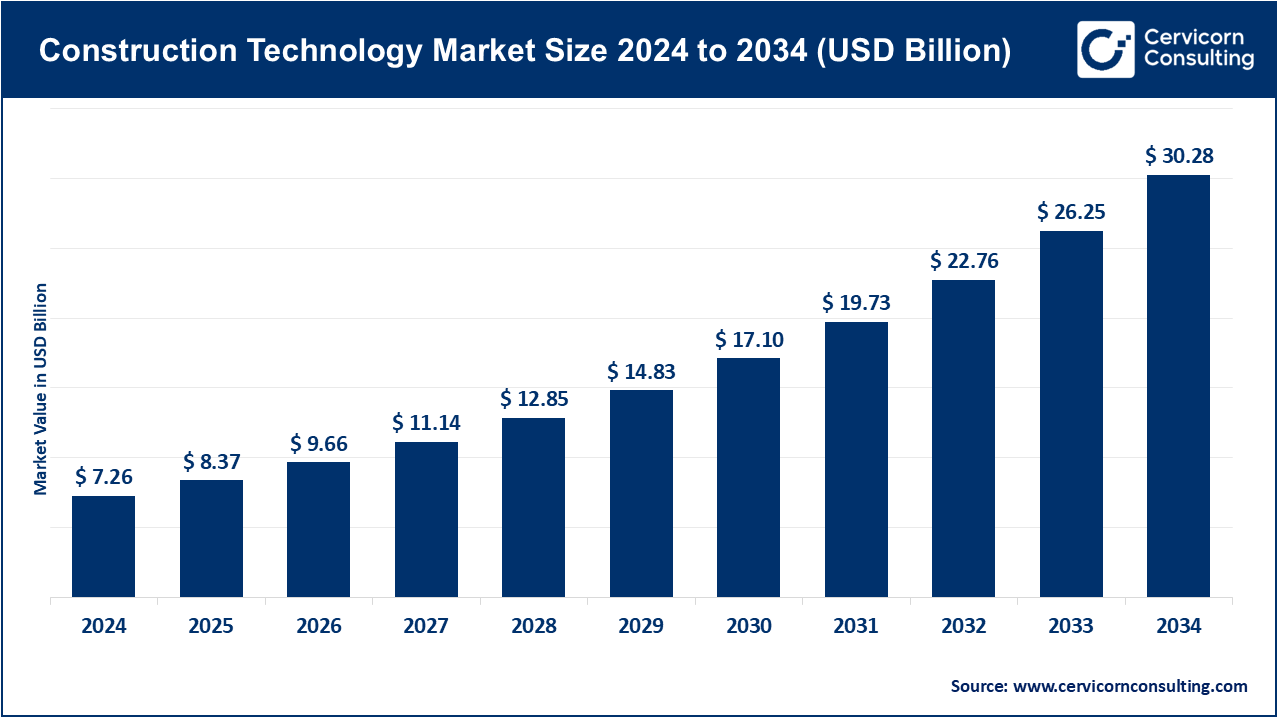Construction Technology Market Overview
The global construction technology market is witnessing rapid transformation, driven by digital advancements, sustainability imperatives, and evolving industry regulations. According to Cervicorn Consulting, the market is valued at USD 7.26 billion in 2024 and is projected to reach USD 30.28 billion by 2034, expanding at a strong CAGR of 16.8% between 2025 and 2034.
This accelerated growth stems from the widespread adoption of innovative solutions such as Building Information Modeling (BIM), drones, 3D printing, IoT-enabled machinery, and AI-powered project management platforms. As construction companies focus on enhancing efficiency, safety, and eco-friendliness, these technologies are reshaping the competitive landscape.
👉 Get a Free Sample Report: https://www.cervicornconsulting.com/sample/2715
Key Market Trends
1. Growing Adoption of Digital Twins
Digital twins—virtual models of physical assets—are gaining traction across the industry. They support predictive maintenance, risk assessment, and real-time monitoring. Leading players such as Bentley Systems and Autodesk are integrating digital twin solutions with BIM platforms, enabling smarter decision-making and reducing project delays.
2. Modular and Prefabricated Construction
Automation and robotics are accelerating the use of prefabrication and modular methods. These approaches enable faster project completion, reduced labor costs, and lower material waste. The adoption is particularly significant in urban housing and large-scale commercial infrastructure projects where speed and scalability are critical.
3. Rising Use of Drones and Robotics
Drones are now integral to surveying, safety inspections, and progress monitoring, while construction robotics automate repetitive tasks like bricklaying and concrete pouring. Industry data shows that drone usage in construction has surged by more than 200% since 2018, highlighting the sector’s shift toward automation.
4. Emphasis on Green and Sustainable Technologies
With regulatory bodies pushing for net-zero carbon targets, sustainable practices are becoming a priority. Innovations such as 3D-printed concrete using recycled materials, energy-efficient machinery, and smart energy monitoring systems are on the rise. Certifications like LEED and BREEAM are encouraging broader adoption of eco-friendly construction technologies.
5. Integration of AI and IoT in Project Management
AI-based analytics and IoT-enabled sensors are revolutionizing how projects are managed. These technologies help minimize downtime, optimize resource allocation, and ensure worker safety. For instance, wearable IoT devices can track worker health and alert teams to hazardous conditions in real-time.
Market Drivers
1. Rising Infrastructure Investments
Global governments are significantly boosting infrastructure development. For example, the U.S. Infrastructure Investment and Jobs Act (IIJA) allocates more than USD 1.2 trillion to transportation, utilities, and broadband, creating new opportunities for construction technology adoption.
2. Skilled Labor Shortages
Labor shortages are pushing construction firms toward automation. According to the Associated General Contractors of America, nearly 89% of U.S. contractors report challenges in finding skilled workers—accelerating the shift to robotics and digital tools.
3. Demand for Efficiency
Construction projects are often delayed and over budget—McKinsey estimates that projects take 20% longer and cost 80% more than planned. This inefficiency is driving demand for advanced technologies like BIM, AI-powered software, and automated project management systems.
4. Regulatory Pressure on Safety and Sustainability
Strict safety regulations such as OSHA (U.S.) and EU workplace safety directives, coupled with global climate targets, are encouraging firms to adopt technologies that enhance compliance, reduce accidents, and cut emissions.
5. Urbanization and Smart Cities
With 60% of the world’s population expected to live in cities by 2030, the demand for smart construction methods is rising. Rapid urbanization in Asia-Pacific, along with smart city initiatives in China, India, and the Middle East, is fueling market growth.
Impact of Trends and Drivers
-
Regional Outlook:
-
North America leads in AI, BIM, and robotics adoption due to strong funding and tech-ready firms.
-
Asia-Pacific is the fastest-growing market, fueled by infrastructure booms in China, India, and Southeast Asia.
-
Europe emphasizes eco-friendly and energy-efficient construction aligned with the EU Green Deal.
-
-
Segment Outlook:
-
Commercial construction benefits heavily from BIM and modular technologies.
-
Residential projects are leveraging prefabrication and IoT for rapid housing development.
-
Industrial construction is increasingly deploying digital twins for predictive maintenance and efficiency.
-
Challenges & Opportunities
Challenges
-
High capital costs of advanced technology
-
Resistance to digital adoption among traditional firms
-
Rising cybersecurity risks with IoT-enabled systems
Opportunities
-
Increasing venture capital funding in construction tech startups
-
Expanding public-private partnerships to support smart cities
-
Growing potential of 3D printing to reduce costs and material wastage
Future Outlook
The construction technology market is positioned as one of the fastest-growing segments in the global industrial ecosystem.
Emerging technologies—such as AI-driven analytics, robotics, modular construction, and sustainable building solutions—will shape the future of the industry. Companies that embrace digital transformation early will gain a clear advantage in building projects that are safer, faster, and more sustainable.
👉 Contact for Detailed Market Insights: https://www.cervicornconsulting.com/contact-us

